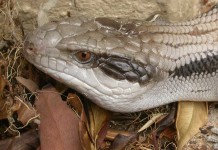The nails of a Blue Tongued Skink can grow to be very long and sharp and just like other pets; you need to clip them off so that they cannot cause serious harm to fellow pets, other skink reptiles and even to their human handlers. A standard human nail cutter or clipper works well for this purpose however, you need to be very careful while clipping the reptile’s nails because it is delicate work and very easy to go wrong with it.
The angle at which you clip is important; do not clip in a straight angle because the direction at which the reptile’s nails grow is downwards so the angle you use should be a sideways one. Having the skink to hold still while clipping is a tricky but important task because you can accidentally clip the entire toe of the animal if it suddenly starts squirming. One tip to reduce the squirming of the reptile is by putting a baby sock on its head; this may work for your skink. Some people can also clip another nail or toe of their skink by mistake if they have been focusing solely on another toe.
Knowing how much of the nail to clip is important as well because you do not want the reptile to be completely nail-less. They need their nails to run, move around and even climb to a certain extent. If the nails are long, then clip no more than half the nail but if they are not that long, just clip a little bit from the edges. If the reptile bleeds a little bit on the toe because of the clipping, do not worry because it does not hurt them.
 The easiest way to get your blue tongue skink’s nails clipped is to have two people do the job because while one person holds the animal and keeps its still, the other can clip off the nails with complete attention to what they are doing. Since this is a delicate procedure, take your time to get this right. If the reptile bleeds a bit during or after the clipping, keep them on a clean paper towel or cotton towel until the bleeding stops before placing them back in their enclosure. This is because the open wound should not make contact with any bacteria that might be in the enclosure or anywhere else. After each clipping, sterilize the clipper for this exact reason so that the open wound is not infected in anyway; it is also more hygienic to keep your skink’s clipper separated from all other clippers in your house.
The easiest way to get your blue tongue skink’s nails clipped is to have two people do the job because while one person holds the animal and keeps its still, the other can clip off the nails with complete attention to what they are doing. Since this is a delicate procedure, take your time to get this right. If the reptile bleeds a bit during or after the clipping, keep them on a clean paper towel or cotton towel until the bleeding stops before placing them back in their enclosure. This is because the open wound should not make contact with any bacteria that might be in the enclosure or anywhere else. After each clipping, sterilize the clipper for this exact reason so that the open wound is not infected in anyway; it is also more hygienic to keep your skink’s clipper separated from all other clippers in your house.












